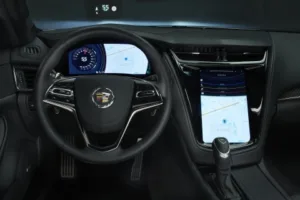Mitsubishi Electric has announced its latest generation of the FLEXConnect In-Vehicle Infotainment systems (IVI) in a press release. The latest system provides a cost effective three screen user interface. The displays contain touch and swipe technology to provide a safe and consistent user interface to the car systems.
The three screen interface includes a 12.1″ center panel touchscreen from MDTI (Mitsubishi Display Technologies Inc.) with a resolution of 1280 x 800 pixels and a 12.3″ (125 ppi) instrument cluster with a resolution of 1920 x 720 pixels (167 ppi). The third display is a heads-up display with a resolution of 480 x 420 pixels.
Source: Mitsubishi Electric FLEXConnect Complete Display
The system runs on a TI Jacinto 6 platform with Android as the underlying operating system. This implementation is a Mitsubishi development and not the Google Android Car platform. As Mitsubishi says, “Built on an Android platform, the center touchscreen allows easy sharing of navigation, media and climate functionality with the instrument panel and heads-up display”. The system runs all three displays from one processor, which easily allows information to be shared between the displays. This means that the user can define the portrait center display into full screen, half screen or into thirds and mix the information based on the their own requirements. This also includes access to FLEXConnect RSE (rear seat entertainment). FLEXConnect RSE was released earlier as a rear seat entertainment system with two separate displays.
The system also supports Wi-Fi to allow users to interact with tablets and smartphones.
The company did not announce when this system will be ready for deployment, but we could be seeing this as early as in 2016 models.
Analyst Comment
Automotive displays have become a larger part of the automotive industry since the middle console displays became high resolution displays and entertainment displays in the rear seats added to the display area used in a car. Using touch technology in the center console allowed many more functions to be integrated, to a level of detail that would not be possible without programmable buttons. This development has been going on for a while and one of the strongest arguments against this development has been the implementation, which was quite different in different car brands.
A car interface needs to be simple and intuitive to avoid distracting the driver. This new system announced by Mitsubishi promises exactly that. The combination of all displays in the car into one control center and controlled by one processor will allow the distribution of images onto any display source in the vehicle. This makes the integration of external sources like tablets and smartphones much easier and will allow users to direct information from an external source to different displays in the car – text messages to the center console, video to the back seat and traffic alerts to the head up display. A very promising concept. – NH

